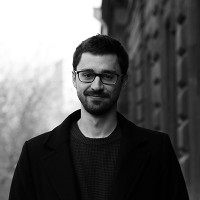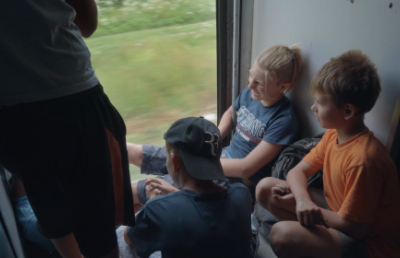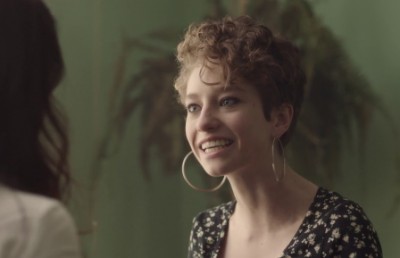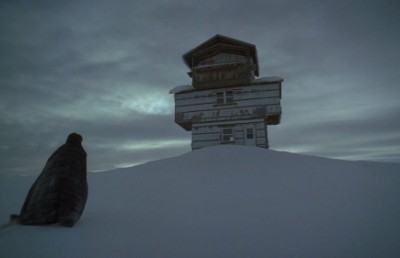RIDM 2019: Interview with Oskar Alegría, director of Zumiriki
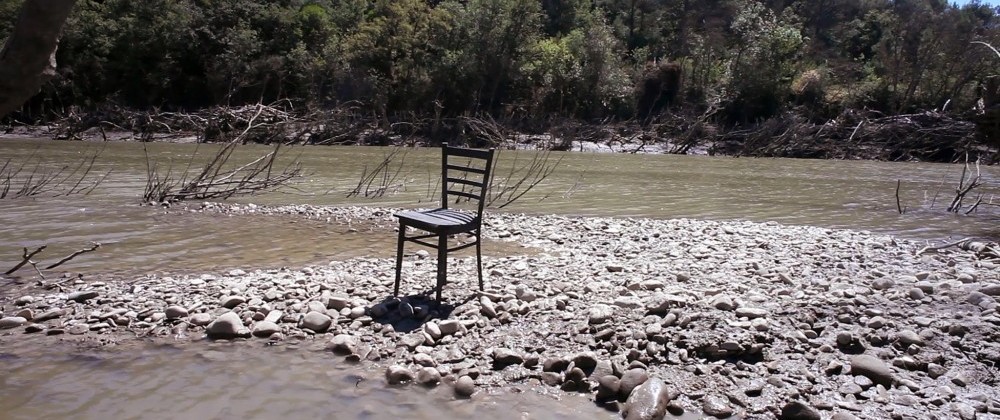
I met Oskar Alegría at the Punto de Vista Film Festival in Pamplona, Spain, a few years ago. Back then, he was already a filmmaker (The Search for Emak Bakia, 2012), but at that time he was also the director of the aforementioned festival. One of the retrospective sections of that year was entitled “Ten Years Older. Time and Cinema”. The delightful program included jewels such as Herz Frank’s short film that gives the section its title, experimental works by Maya Deren, Hans Richter, Guy Sherwin and Martin Arnold, or the work (Nostalgia) (1971) by Hollis Frampton. The different parts were entitled “The Ages of Man”, “Modern Times”, “Time Without Us”, “Disarming the Clock”, “Composite Past”, “Continuous Present” and “Simple Future”. Some of Oskar Alegría’s central concerns could be guessed in that personal program: time and all its variables, related with the preeminence of the past and its echoes in the present, the nostalgia for childhood, the wish of keeping the time still, or the possibility of combining all this thanks to cinema, a wonderful weapon, as described by Alegría himself.
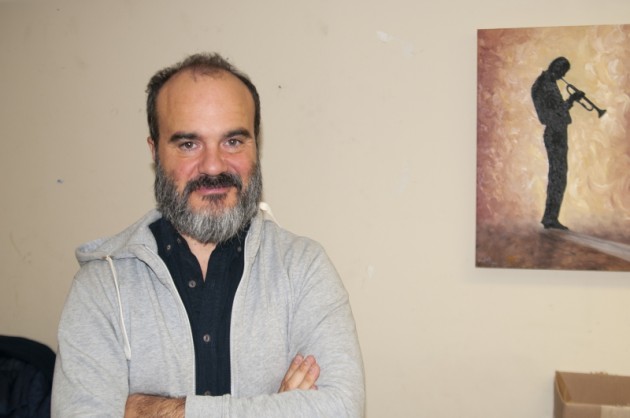
Oskar Alegría
We met him after the screening of his latest film at the Montreal International Documentary Festival (RIDM), a festival that the Spanish filmmaker already knows well. Zumiriki (Oskar Alegría, 2019) is a handcrafted film made in a forest. But not just any forest, but his forest, as he calls it, which can also be, why not, an inner, intimate place. That isolated spot began to exist in his childhood, when he made it his own, and that later has continued to be his because it survived in his memory, and that has finally formed part of a project of re-appropriation, or perhaps of recovery, because one cannot appropriate what is already one’s own.
Since the landscape of childhood has changed, and he too has changed, there can be that initiatory journey to know the roots, to be accountable to the past, to discover oneself by looking back, to that lost paradise from where there are still some echoes that remind the filmmaker that it once existed and that he witnessed it.
Some trees half submerged remind him that there was an island in the middle of a river, some recordings of his father where his voice as a child can still speak for him in the present… Zumiriki is made up of a multitude of layers. What is not easy is to know which layers overlap others. The family past, the memory of the home on the island, the neighbors on the other side, the letters, every element helps think about the others and in the whole reconstruction of the memory.
This journey full of nostalgia is not, however, free of sarcasm. What seems to be an act of a certain grandiloquence for the film like throwing a few letters into the river inside bottles, turns against the director who wants to control every detail, as the bottles get stuck not far from there. But everything fits within the created symbolism. The cards he throws go back to him… towards his film, which is the real letter. The film is full of details, some created with grace in the editing, like the superimposition of images in the forest, where wild animals seem to prowl around the sleeping filmmaker.
This and much more is Zumiriki. Oskar Alegría helps us unravel the many nooks and crannies of his work before he goes to watch an afternoon session at Cinéma du Parc.
Offscreen: How many festivals has Zumiriki been through?
It’s a newborn at film festivals. It started in Venice in September, and in Italy it’s going to be quite a bit. And it’s curious because this film has two languages, which are the two languages of my biography, Euskera and Spanish, but there’s a third that doesn’t come out much, which is Italian, with the clown from the film that speaks Italian, Enrico Caruso’s song… Since the film was presented in Venice, I think that this can help to visit other festivals. Then it was in Barcelona, Seville, Morelia… Maybe this is the fifth or the sixth festival. It’s not bad but it hasn’t stopped. In January and February there are fewer festivals… It’s very different if you finish a film in summer or in spring. I finished my other film at a different time. It had premiered at BAFICI in April, and it took a different route. There are people who even finish the film, but wait to release it in winter because it makes another tour. The film is also getting burned and doors are closing. There are festivals that cannot host the film if it has been in other festivals or cannot be in competition. Venice is an unimaginable beginning for a film that was an enigma even for me when I finished it. The other film I think was clearer. It seems that I had more official points to fit in. This one, however, created more mystery for me. That’s also why each festival that selected it was more surprising to me. In December I go to Italy, to Trento and Naples, and then to an island in China, I like the film to go to an island, and from there to Havana, also to another island, then to Peru and finally back to Spain. I’m going to travel against time. I think there’s some of that in the film too, it’s a journey against time.
Offscreen: What have been the reactions of the public so far?
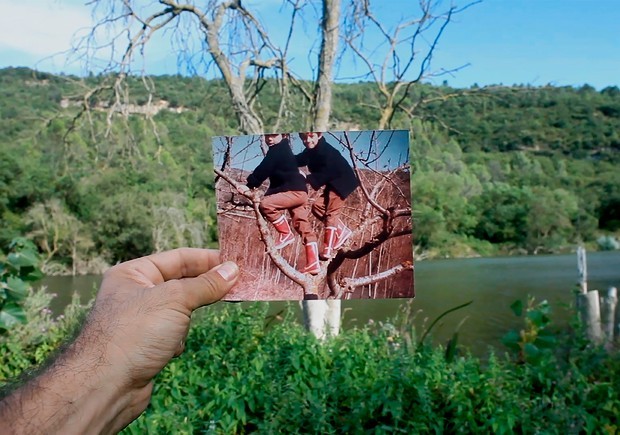
Yes, reactions can be measured. I often said the opposite. For example, in yesterday’s session, how did it work? I don’t know. I think it was a shy session. I’m shy in cinema, I’ve never approached a filmmaker, I’ve never dared to ask. There weren’t many questions. But the shy ones seem to me to be the best in the world. And there are times when some days later someone writes to you. You notice that he’s been there in the corridor waiting, but he hasn’t come to talk. I have been that person. At the end you find the director’s email, you write to him and say something, and it’s nice. For me yesterday was a nice shy session.
Offscreen: Your previous film was also in Montreal…
This is the third time I’ve been here. The first year I came with the first film and the following year I was brought in as a jury, which was also a nice experience. Repeating the festival encourages you. On the flight I read an interview with Angelopoulos that I had saved on my computer, where he says that every film he made was more uncertain, contrary to what it might seem, that seniority gives you a degree, a security… He said no. Every film I make seems more mysterious to me. And it happened to me with the distance between these two films. So, repeating at this festival is a way to help me believe more in what I’ve done.
Offscreen: The word “zumiriki” means “island in the middle of a river”. What does that island in the film and that word mean to you?
I was lucky enough to have a father who collected the last words that were in the Basque language of his village, which are words that have only been said by them. The other day in Mexico I told a person the meaning of “zumiriki”, and he replied: “how nice when there were words for that”. Of course, we no longer use “zumiriki”, but it was used at the time of my father and my mother, because my mother also washed clothes in the river… we don’t have to go that far, a generation before us there have been people who have washed clothes in the river. My father was also a shepherd by that river. For me “zumiriki” is a very important word, because it is the last one in my father’s dictionary. Our only ambition may be what I said yesterday in the Q&A, to save the last word. The rest of the words will disappear, but the last word, at least, is saved. Before making this film, if you typed the word “zumiriki” in Google, three results would come out of an interview where I had mentioned it. Now there are about eight thousand. But well, at least we have achieved an 8000, which is like the Himalayan peaks. I have always believed that if the word disappears, what it represents also disappears. If “zumiriki” was an island under water, cinema, that wonderful weapon, allows you to at least save it.
Offscreen: Where did the idea for the film come from?
There are very good stories that come from a letter. And all this also comes from a letter. My father, when this dam was made and the river bank is flooded, the house on the island disappears, and yet letters keep coming in about that property. I see this landscape broken. Thanks in part to those letters, because they keep saying that there is a land that we don’t see, but that bureaucratically is still registered. It’s an interesting thing. How far do things disappear? I love to tell stories, and if you can tell with images, better. My father shot some movies in that area. There was a stage for a film and it would have been a mistake to miss that opportunity. After making a film like The Search for Emak Bakia (Óskar Alegría, 2012), I thought: “I don’t know if I’m going to get a story that results in a feature film”. And everything comes from that, from how this landscape is altered. I think this landscape is a great stage to enter with your camera to play with memories, to propose an essay. I think that the film is a great field for playing that wonderful thing that is cinema, to be able to play twice.
Offscreen: Do you think it’s also a way to deal with the past?
Yes, because, in the end, this cabin in the forest has the shape of a memory. Sometimes I say that I haven’t locked myself in my forest but in my memory. This is not just any forest, it’s my forest. Experiences such as Walden (Henry David Thoureau, 1854), in nature, have been made many times, but I had not read so many that were an experience in childhood itself. That is the area of the world where I hear myself as a child, I still hear the echo of my child’s voice. In my father’s films there is my voice. Using that voice for the present seemed like a way to try to return. And the film has a central question, which is whether we are able to return twice to the same memory.
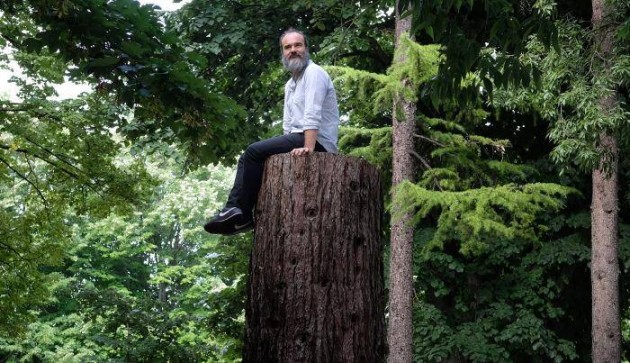
Offscreen: What has the process of making the film meant to you on a personal level?
There is one thing that is the film, but there is another thing that is the experience. It is said that the book is always better than the film, but the experience is always better than the book and the film. The film lasts two hours, it conveys brushstrokes of something, but it doesn’t convey what it has been for me. Sleeping in the trees of my childhood again, the trees where I climbed as a child, despite the difficulties of progress, which has brought a lake in the middle of the river. To achieve that and then make a film that is suddenly selected in Venice… A handcrafted film, made with home-made elements, as my father did, who also recorded the plants, the landscape, the pilgrimage of his village. So, achieving that the bottle you throw into the river of your village, from this small corner of the world, reaches the lagoon of Venice, is a personal experience that gives you tremendous satisfaction. Which at the same time worries me a little, because it’s a dream already achieved; it’s as if I’d been left without a dream. What do I do now?
Offscreen: You commented yesterday in the Q&A that reading Quixote in that hammock in the film is not the same as reading it elsewhere. Can you develop this idea a bit?
I took seventy books with me for the four months. I think about what is said about what three books you would take to a deserted island. And why three, why not taking seventy. I’ve almost always read in the air. I set up a library that I called the air library, and most of the books are books starring people who climb to an elevating point, which can be a tree, a tower or promontory, or that are written from there. For example, the Essays of Montaigne are written from a tower. There is one by Victor Hugo that I didn’t know about and which is called The Promontory of Dreams, which is a rock in Brittany, where he climbs up and writes from there. So, there are books written like that, but to be read like that also seems to me to be closing the circle, giving the book the essence it deserves. And indeed, Don Quixote, which I had read twice on the ground, I have read it again in the air and it is a tremendously different book. Well, all it suggests is not only due to be in a hammock, it is to spend two months in a tremendous sense of freedom, in a forest where you feel like a happy child, surrounded by birds and animals that come to meet you, in a solitude and a secret. In a very quixotic state.
Offscreen: I think one of the deepest scenes is those conversations with the elderly shepherds. How did you manage to convince them to be filmed?
It’s not that difficult. The hardest thing was to convince the dog, rather than them. There are several previous visits. I always go with an ambassador, I don’t go alone. Basque-language helps a lot. And even more so if you speak their language, their Basque, because there are special dialects in these areas. Besides, the doors of these cabins are always open. If besides you are someone who has made the effort to speak Basque it is easier, because they notice that you have made the effort to learn. I do not speak it perfectly, but they realize it. Then they receive you as a brother. And after several visits I asked them what was the last day of their stay there. Some of those shepherds had been in those huts since they were twelve years old, that was their universe. And then they warned me: “on October 20th my daughter is going to come to pick everything up and we are going to leave”. And I said: “I want to come here the day before, because I want to spend a whole day without talking to each other”. I made a small pact with them, because I realized that the nice thing was to shoot these heroes of the waiting in silence. What they use is above all a chair, and they practice the highest waiting, which is to expect nothing. So it wasn’t difficult to convince them. I thought I’d wait until nightfall to ask them just one question. Because that’s something I also pursued in the film. Going to the opposite shore, the shore of mystery, the shore I saw as a child and which we never crossed, not to reveal the mystery of that shore but to check that the mystery is still alive. That is one of the things that has reassured me the most in this experience, that is to say, that shore is still the shore of the mystery. In spite of all the progress, all the light, all the communications that have advanced, that shore still keeps a secret, but I don’t want to know what it is. I just want to know that it exists. On this night of the shepherds, I didn’t want to ask for a long interview either. It is as if with a flashlight you give a flash to that darkness, and then you leave. That question is the flash, that is, the mystery is there. And they accepted it very easily. They are 27 times smarter than me. These shepherds are little philosophers, they have been thinking all their lives in front of a landscape in solitude. So, it’s very easy for them to give you a very big little reflection. It caught me a little at a loss, but it also seemed honest to me when it was time to wake him up and take him a little out of that dream and say: “I have no question, you ask the question”. And he asks a question that, imagine it… when the film was first shown in Venice, the Sala Darsena, a cathedral for 1500 people, all dark, the anti-cinema, and a lost shepherd from the Basque Pyrenees who asks, in a festival of red carpet and celebrities, “ What are there so many stars for? It’s not “why”, it’s “ what for”. This detail seems very important to me. The dog was harder to convince, in the sense that the dog didn’t know about this pact, and I remember that at the beginning of the shoot I was trying to get the dog out of the way. But there is a time when the dog also understands the whole film and even plays its part.
Offscreen: I wanted to insist on this night scene because it’s really surprising the intimacy that is created in the darkness, where suddenly someone tells you a dream…
Yeah, but I think it’ s because of the previous work. If you’ve been with them all day, even if you don’t speak, that creates complicity. I had spoken to them before the shootings and I already knew enough to ask one about death because I know he’ s a person who had a couple of serious accidents. But if I had done that interview in daylight it would have been very different. I surprise myself sometimes when I’m shooting. I was shooting and realized I was on my knees. Suddenly the night comes, I fulfill the pact, I don’t intervene immediately, but I hear a breath, I hear how the night starts coming soundly, and when the image is gone, I realize that I am on my knees before a sacred scene. It is the last night of the shepherd… From these four shepherds there are two who no longer live. Look, if it’s not recorded then it’s not recorded anymore. Anyway, they are now in the film forever.
Offscreen: Another important scene is that sound composition with the voices of the shepherds…
The one with the ox cart. There are these micro stories in the film, these detours. For me, the art of the detour can go well or badly, but I’ve come out of the story to be more in the story; it’s a bit paradoxical. You seem to come out of a story that is more of a wreck in memory than a forest experience, but it’s easy to connect. I don’t want to make a very direct connection. I prefer to give it. But in the end, it’s also something that is repeated in the film and I think in all my work: playing at trying to recover what fate has taken from me. That is to say, there is a film [Gure Sor Lekua (André Maldré, 1956)], historical for us, because it is the first documentary with a script in Basque, of which unfortunately the sound coil has been lost, so we have only recovered the image. That sound, which is so interested in collecting the first words in Basque in the cinema, is erased. In the end, in the landscape where I am making this experience of shipwreck, the first thing that disappears is the sound as well. When a river is blocked by a wall, the current stops sounding. And for me and my brothers it’s the first thing that surprises us when we visit the river. We think that there is no river anymore, because if it doesn’t sound it’s not a river, it’s a lake, it’s something else. And it is a river where I also heard the first words in Basque. For me the connection is that they have made the island disappear from my sight, although the trees mark that it is still there. The sound reel of that ox cart has disappeared, but we can play filmically to get them back. But how? Well, with the weapons of cinema, some creative weapons that make you hear for the last time that the ox cart step and, moreover, in the sunset, when it comes back, where there are four old people of whom two will die a bit later. It is not easy to find a person who knows how to imitate that ox cart. Other generations don’t know what that sounded like. The old man imitating the ox cart died four or five months after making the recording. But that’s where he left that wonder, which I think is as beautiful as that ox cart passing by, coming back in the afternoon. The last person who appears, the one who makes the wind, when I asked him to give him a role in my last film, to make wind. The shepherds understand it completely, because his answer was: “what kind of wind do you want?” So, it’s easy for me to play at that too, because they really don’t know, they know something about how I’m going to use that audio, they know a little about my work, and that also helps. But they don’t know what the final scene is going to be like, and they haven’t even seen it. Then I like to show it to them and they surprise themselves. At the end, among four Basque elders, we recovered a bit of the sound of that film that had disappeared. It’s a bit like saying that our river, that river that no longer sounds, I also hear it a bit in the film.
Offscreen: Alegría Did you think of those scenes during the editing?
It’s a project that I’ve done separately. I’ve been recovering the lost sounds of that film. Then I have several sounds. The central scene of the film is this ox cart that comes back in the sunset. And while editing it, like the nights of the shepherds, I also felt like leaving the story. Because being in the shipwreck all the time seems a bit claustrophobic to me. It’s a little unblocking, to stop hearing the voice of the narration and move on to another scene and come back. It’s like getting some air and going back in. So, I think it also gives the film a little rhythm, but it also gives it a lot of meaning, because the film is full of shipwrecks. And the shepherds are shipwrecked on land, and the sound disappearance of a film is a shipwreck.
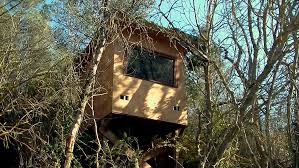
Oskar Alegría reinvents his childhood treehouse
Offscreen: How much does the initial idea change from the final result?
Good question. It’s just that there wasn’t much of an initial idea. The initial idea is just the map of the cabin. The idea was to establish a cabin in the middle of the island and live an experience in front of that memory, try to enter the island, see the trees up close, dedicate the film to the trees. But there I discover that there is a connection between the two trees and a possible conquest. But that comes out during the experience. I like to see that the script for the film was a blank map, a map that appears. It was fortunate to have, in an area of my community, a map that has no names, that you can put if you inhabit it. Nobody lives there. If there’s a time when you live there, or you go fifteen times along the same road, along the same rock, then you name it. To explain that world to you. Because in the end it is to create the world, to give it a name. Then, the initial idea was unknown, it was very uncertain, because I didn’t know if I was capable of being there for a month, because of humidity, mosquitoes, loneliness… that I didn’t know if I was going to be able to endure. I saw that the film was being built… The other day a friend said to me: “I see a do-it-yourself in the structure”. The cabin is built just like the film. One letter, another letter; you put one board, then another. It’s getting ready. You even have two pieces left over, like when you assemble a piece of furniture where there are two pieces that you don’t know where they were going, two screws that you have left over. Then, from the initial idea there was a little bit, and for me everything has been a surprise because working with animals, for example, is something you can never control, if they are going to appear or not, what kind of role they are going to play or not, what kind of approach they are going to have or if they are going to escape. So, there is not only the runaway cow that escaped, which I thought I would never find, but also the civet… There is a whole cinematic relationship with the civet from beginning to end, there is a cinematic domestication, which seems to me to be an attempt to be the man from the other side, the man that I saw as a little boy with a fox as if he were a dog. It seemed to me a marvel that a fox followed him, I thought about how it was possible that he had managed to make that fox his pet. Then, in the end, the civet also got closer and closer: when he saw that my chickens could not be eaten, we began to have a relationship, which cost me my tins of sardines.
Offscreen: How was the film achieved on a technical level?
The main camera is a Canon 5D with three lenses, which is the one I’ve always recorded with. And that’s the one with which I do all the self-filming. Then I bought four camera traps to shoot the animals, and I also had an underwater camera that can dive five meters. Each one gave me more surprises. For example, the underwater camera, which picks up the sound of bubbles. It is the last oxygen in this river, since what a dam kills is the oxygen in the river. Also, they sound like a dying heartbeat. That was also a big surprise of that camera. As for the camera traps, I would sometimes pass by and fall into my own trap. There I, too, began to reflect, thinking, “I don’t mind being in the image; if I shoot the fox at night, why not myself?”. It’s a bit of justice, if you’re taking out the fox’s intimacy, why not take out yours. These are also cameras that allowed me to play, because one of the keys to endure four months there is not to get bored. Having these cameras distributed throughout the forest is a wonder. Every day you go to see if any animal has appeared, if not, you improve your traps, your tricks. And that allows you to be there for a long time. And the last part is a filming feat. In four months you have all the time in the world. I would put some ribbons in the trees where I would put the tripod and American tape so that it wouldn’t move too much, although it has a little tremor, which I like, because it’s the tree that really shoots. The feat was to activate them and stop them again, although sometimes I didn’t even stop them. There are people who ask me if I was alone… but it consists of doing the scene three times changing the camera very carefully, because you are working in the water. Once, some of the material fell off. The river eventually steals things from you. In the end I realized that it was like shooting a final dream, and when you are determined, everything works out. I saw the danger before it happened. I saw a snake on a rock where I almost put my hand. Also, there was a rope that was going to come loose, but something was helping me. Self-filming has been interesting in the sense of survival. Notice that I felt a bit like shooting the old-fashioned way. When filming was made in celluloid, shooting non-stop was not possible. Now, digitally, we are recording constantly and nothing happens. But when you’re in a forest where you have a solar panel that charges your battery very slowly and you have cards that you can’t fill either because you can’t empty them very quickly, you’re in a shortage, just like with food, because each shot is like a glass of water, you can’t waste it. And I didn’t use to check what I recorded, because the monitor also wastes battery. Then, I would cross my fingers expecting to have be focused correctly. It’s very difficult to focus. And think about focusing late at night. You have to develop a tremendous eye and put small samples to focus. You have to measure everything so much… Then, doing postproduction, I remember that Luis, a person who helped me, told me that all the shots are impeccable, that there are no outtakes. It’s just scarcity. It forces you to be precise. If you can shoot fifteen times, you just shoot and shoot, but if you can shoot just one, you have to nail it. I had the exact material.
Offscreen: I had doubts about batteries and memory cards…
I had a hard drive where I could download some cards, and also a solar panel where I could charge a light bulb, I could charge certain things and also the batteries, but very slowly, there has to be a long sunny day for them to charge well. I had made an agreement with the owner of the farmhouse above to leave the material in a hidden place every two weeks, although we never saw each other. He charged my batteries, discharged the material, and I picked it up, otherwise I wouldn’t have been able to do that, of course. But last month I didn’t take anything up. The cards were filling up, and I saw that I needed to do three scenes and only had a 16GB card. They had to come in here. That’s when the aim is activated. I, for example, draw very badly, I never did well at DIY, but I’ve been surprised there that I didn’t do so badly, because I have to. I have three boards and I have to make a table . If you now force me to make a drawing of a tree here, which is a very difficult thing to draw, it would be awful. But that’s where it has to come out. I believe that in scarcity skills is activated. And with the shots of survival, to call them in some way, it happened the same, that is to say, I just nailed them. I’m sure that if I’m shooting outdoors, with equipment and so on, it doesn’t come out. Or if, mentally, you know you can have a support, you don’t get it. If you’re alone and you’re obliged to do it, you’re going to do it. Because you have to survive with it. I discovered myself making a table that wasn’t bad. It was comfortable, I used it for four months and it worked perfectly. Or these little trees that I draw, that there has even been a director of a festival that has asked me to make an exhibition with them. He said: “drawing a tree is as difficult as drawing a hand”. And it’s very similar, too. And they say it’s the hardest thing to draw.
It’s a survival cinema. I think it’s interesting, I hadn’t thought about it before but when I’m talking about the film I realize it. In the last month, above all, I made an exact accounting of how many cards and how many batteries I had. And I said to myself, this is what you have to finish the film with. There’s no more, you can’t waste. And I remember that last month was when I shot most of the epilogue, and the cow, but it was fair, I did not do too many shots. And I didn’t check them or anything.
Offscreen: I wanted to ask you about the editing, because I imagine you must have had an enormous amount of material…
Yeah, but it was all chronological and that helped a lot. I’m losing weight and I have a beard in the film. I can’t go backwards. I can’t use shots from the beginning at the end. There would be a lack of raccord [continuity]. Everything was chronological, like the construction of the cabin, which is a little conquest of the land. Let’s say there are like three parts: the conquest of land, the conquest of water, which is after having built the cabin camouflaged and reach the trees, and then the conquest of air, which is to try to climb the trees again. There were already three chronological blocks where everything fit in. And then the scenes of the animals, where there was a lot of material, especially scenes without those animals. There is a sequence where I talk about the cameras capturing nothingness. It seems to me to be one of the most beautiful parts of the film, which is when the film is being emptied. You go there with an objective to capture animals. I realized that in these hiding places where I went into the woods, when I went in without a camera is when I saw more animals, when I went in with a camera I saw less. Many times I would say: “Well, let’s enjoy the nothingness”. There are many images that would be considered discards. That is to say, sometimes the cameras are activated by the wind, a humidity, but there are wonderful scenes in the middle of the night, with a strange noise, and you see that nothing happens. A few specks of dust, to figure out what that will be. Going back to the shepherds, it’s the mystery, and that’s the edge of the mystery.
Offscreen: There’s a lot of nostalgia in the film, but there’s also a lot of comic elements. How do you get both aspects?
Of course, because it’s a child’s film. It’s the place where I hear myself as a child, where I’ve played. That was our summer yard. Where every summer our brothers, cousins and I played, it was a children’s paradise to have an island to conquer, trees to climb on. When I came back as an adult, unintentionally I get that child again because it’s also revisiting. To hear you again, as a child. So, there are moments of the experience in the forest that seems a little ridiculous, but they are funny. I’m eating dinner, I leave some dinner and an hour later an animal always appears to finish it. Or where I slept one night in the middle of the forest, just the next morning a fox appeared smelling that where I had been and urinating to mark the territory. I am playing with nature and those moments happen. As you said, linked to nostalgia, because I believe that the film also does not pretend to be a manifesto or of great sorrow or great pain, because in the end what I’m doing is to rescue a word from the shipwreck, getting a small big victory. And that’s celebratory. It’s not a cry. There are two paradoxes in the film, but one that I really like is that it is a film full of words but that works like a long minute of silence. There seems to be a respect as well. A respect for the ancestors, for the people I see who have passed through that area. I see my grandparents always there, in that chair I have, in the trees they planted. So, it’ s like a gesture of taking off one’s hat before them.
Offscreen: Yesterday you mentioned the word twilight in connection with the loss of the Basque language. Is there some kind of political intention?
It is a poetic intention. Absolutely. Which I think is the best vindication. If I feel a homeland, I feel that it is poetry. And it seems to me that it is a place full of poetry. For me the Basque is that landscape, the landscape where I discover a language spoken by two people from shore to shore. And they are the last speakers of that place. So, for me, Basque is a bridge that flies between two shores. And the only claim there is the nostalgia for a world that is lost there, that is lost in León, in the Amazon and in Vancouver. It is not just a nostalgia of one’s own, neither small nor of a place. And I believe that the greatest enemy, if there is an enemy, is progress. Time. It’s a time that the film tries to stop. The ideological charge is only against time. Let’s try to live on a shore where there’s no time, to see what happens. So I think I am looking at a very primitive thing, is to be in balance with the earth. Like that man on the other shore. What I like most about the only picture I have of him is his way of being on earth. It’s what a scarecrow represents. It seems to me that it is a way of being on the earth that we have lost. The closer we get to that, I won’t say we’ll be better, but we’ll recover things that are gone and it’s not good that they’re gone. Among them is language. A language that also ties you to that particular landscape.
Offscreen: To conclude, do you consider yourself more of a filmmaker, teacher, festival director…?
I’m a former festival director, I’m an ex-professor, I’m still not an ex-filmmaker. There is one thing I think and I say it honestly. The bad thing about making a film is that it forces you to be a filmmaker. I like making films, not being a filmmaker. I don’t like having to talk about the film, I have to be here, I have to present the film, etc. But I would really like to make the film for the sake of making it. I get tired of having to hear myself talk about the film. I have to make an effort, because, well, it’s true that it’s good. And it’s also true that I’ve had experiences that I’d like to tell you about, to share them with you, I think that’s good. But what do I consider myself? A lot of people say this is a Robinson Crusoe experience, but I think I’m more of a Friday. If I can play a castaway, I choose Friday. And as I told you before, I think the greatest castaway is Friday, not Robinson. They change Friday’s name, but we don’t even know his name. To take away a person’s name is to take away his being. So, in this area I’ve felt more like Friday, because it’s my area. I am not a newcomer, a person who accidentally appears there. I am the person who walks around barefoot, and the person who knows how to name the places, that’s why I consider myself a Friday.
Offscreen: Do you have any other projects in mind?
I want to write a small book, taking advantage of the round-the-world trip that this island is going to give me, called The Portable Island or something like that. It seems to me very magical that this happens, that from a small island suddenly begins to make a trip, and that trip also takes me around the planet, from island to island. I’ve told a story from my little corner of the world, but sometimes the echo of this little corner can get farther than we think. Then, in spite of all the ups and downs of that world tour, because there are hours of waiting, connections, airports, customs passages… for me it gets better if I get a little story out of it. I don’t feel like doing the green book, because I’ve already done that during the experience, and it would be very similar to the film, and I think we’ve read many green books, since there are several of an experience in the forest. The opposite of this forest is the airport, a non-place, while for me this forest is the place-place, a place with capital letters. I want to see what echoes of that experience in this forest, of that experience enclosed in my memory, are reproduced in the other extreme. It can be a project that extends perhaps also how beautiful all this has been, and how important it has been for me as well.

